Drip coffee makers have their fans because sometimes it's convenient to brew a whole jug of coffee without any distractions. However, there is a caveat: if you prefer to use bean coffee, you must first grind it properly.
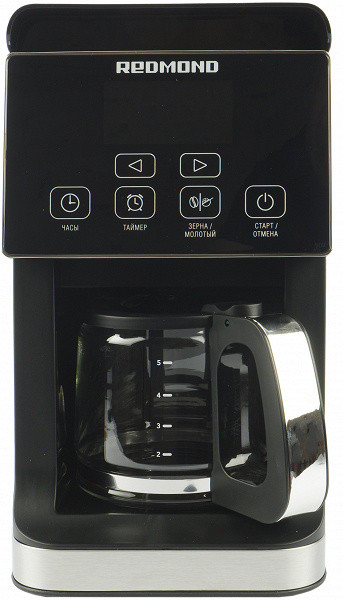
But, as it turns out, there is also a “two-in-one” device: the Redmond CM703 can both grind and cook. Let's see how she does both.
Characteristics
| Manufacturer | Redmond |
|---|---|
| Model | CM703 |
| Type | drip coffee maker |
| Country of Origin | China |
| Guarantee | 1 year |
| Life time * | 3 years |
| Type of coffee used | ground, grain |
| Built-in coffee grinder | There is |
| Heater type | flow-through |
| Jug volume | 0.8 l |
| Jug material | heat-resistant glass, plastic |
| Water tank volume | 0.8 l |
| Anti-drop function | There is |
| overheat protection | There is |
| Delayed start | There is |
| Adjusting the grinding degree | There is |
| Number of grinding levels | 3 |
| Weight | 2.95 kg |
| Dimensions (W×H×D) | 331×305×169 mm |
| Network cable length | 0.9 m |
* Contrary to popular belief, this is not the time limit after which the device will necessarily break down. However, after this period, the manufacturer ceases to bear any responsibility for its performance and has the right to refuse to repair it, even for a fee.
Equipment
The coffee maker is packed in a gray cardboard box with a branded design and full-color printing. The front side shows a photograph of the device being turned on, and the side faces contain technical specifications and additional information from the manufacturer.
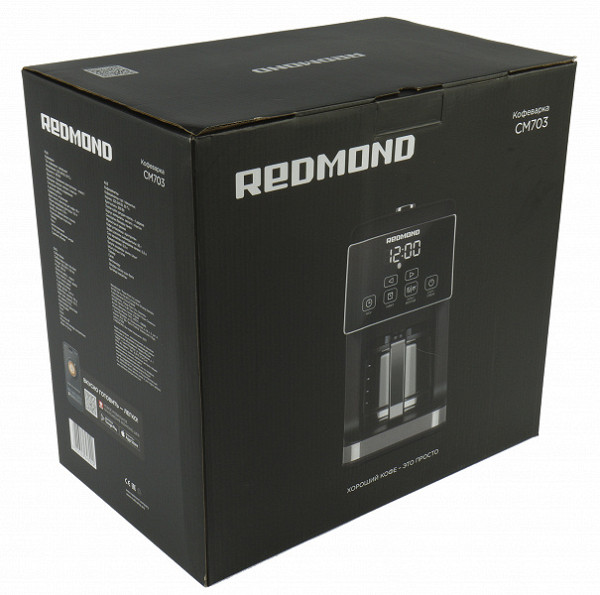
The inscriptions on the packaging are presented in three languages: Russian, English and Kazakh. Inside there is a coffee maker, a glass coffee jug, a measuring spoon combined with a cleaning brush, a user manual and a service book.
At first sight
The Redmond CM703 is noticeably different from classic drip coffee makers, even at a quick glance. Let's start with the body: it is made in the shape of a beveled parallelepiped with rounded corners, made of matte black plastic and decorated with metal decorative elements.
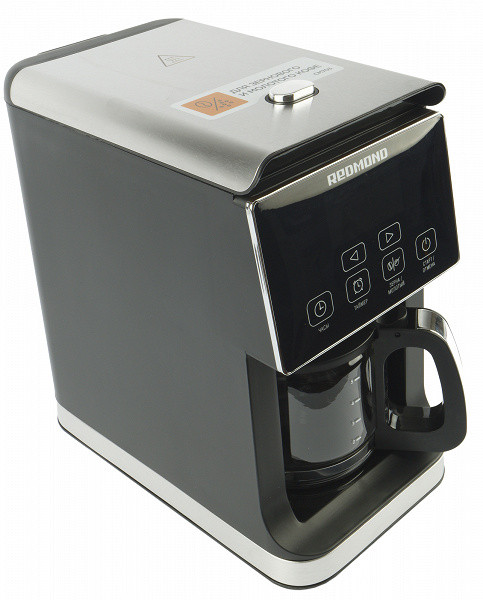
On the front side there is a control panel with six buttons and an LED display. The indication is not visible when the device is turned off, and we will look at it later when we turn on the coffee maker. Below the display there is a niche for a jug.
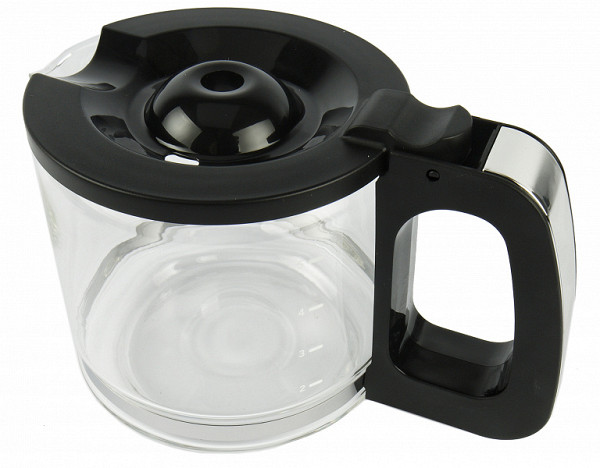
The walls of the 0.8 liter flask made of heat-resistant glass are marked with water level marks corresponding to 2, 3, 4 and 5 servings of coffee. The handle and hinged lid are plastic.

At the bottom of the niche is a traditional round heating element that keeps the drink hot.
When the carafe is in place, a protrusion on the carafe lid presses on the spring-loaded anti-drip valve and opens it, preventing coffee from dripping onto the heating element.

The side walls of the device are smooth, without decorative or functional elements. Access to the sides and back panel is not required, so the coffee maker can be installed even in the limited space of a small kitchen.

Under the hinged top lid there is a water tank and brewing unit.
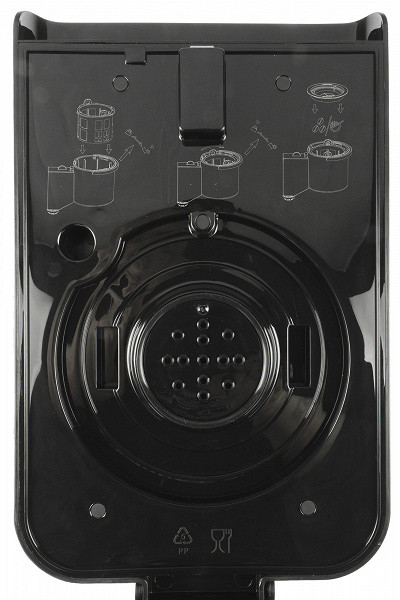
On the inside of the lid there is a plastic “shower” through which hot water enters the brewing chamber. Next to it, the manufacturer placed diagrams illustrating the use of the device.
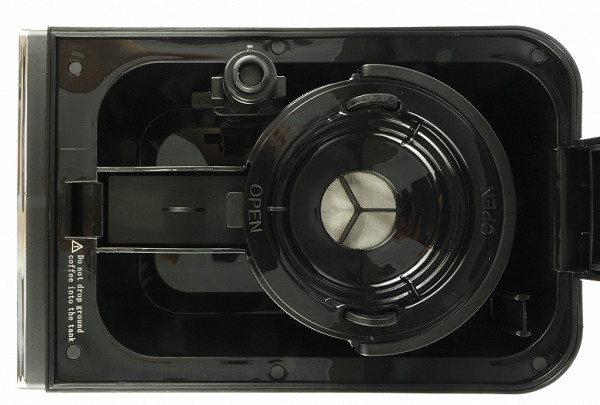
The brewing unit and water tank are made of the same smooth plastic as the body.
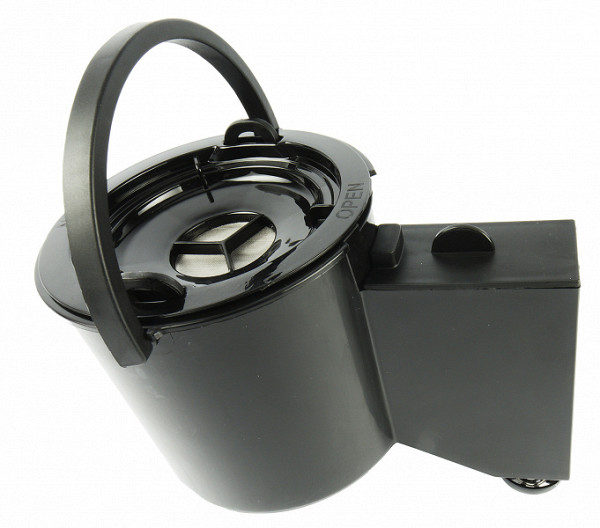
The block is a reservoir with a protrusion, in the lower part of which there is a spring-loaded valve for dispensing a drink. For ease of removal, the design has a folding handle.
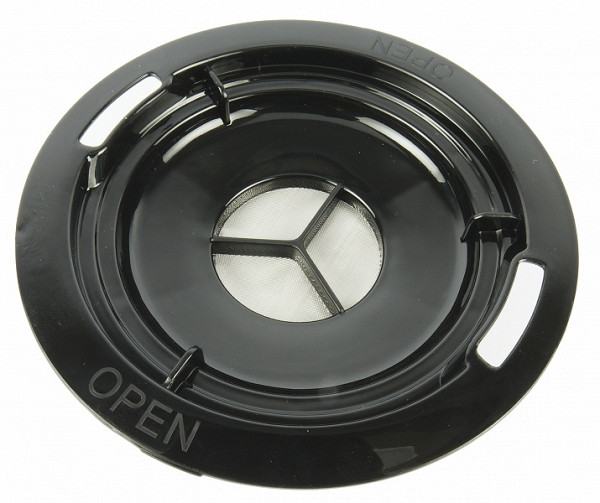
Hot water enters the brewing chamber through a lid equipped with a hole with a fine steel mesh.

The internal space of the brewing chamber is a bowl of a rotary coffee grinder. When using coffee beans, the device first starts the grinding motor and then supplies hot water to the container. The finished drink is filtered through walls with a metal mesh filter.

The coffee grinder blade is driven by an electric motor hidden in the main body. The force on the rotor is transmitted through plastic elements.
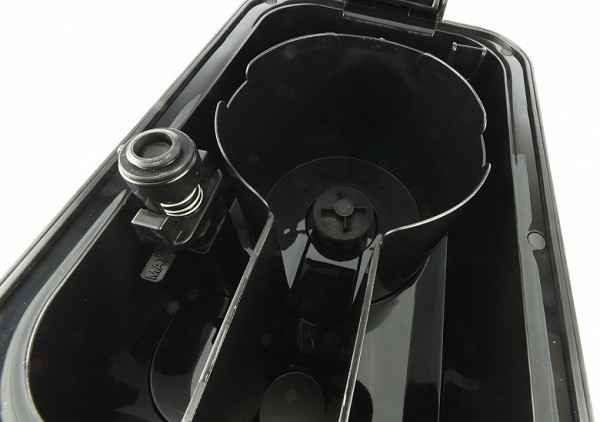
Around the brewing unit there is a water tank with a capacity of 0.8 liters, which corresponds to the volume of a coffee jug. The maximum level mark is located on the tube through which hot water is supplied to the lid. There is no liquid level sensor in the tank, so the device is not protected from being turned on without water.
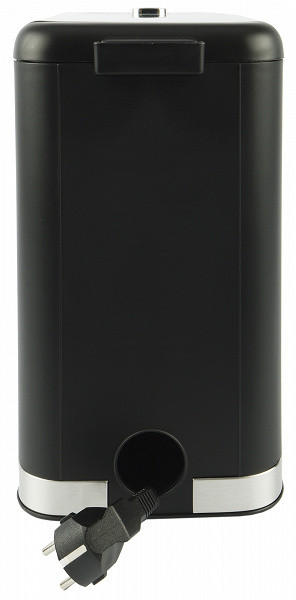
The electrical wire, coiled in a spiral, comes out of the back wall of the coffee maker. The round compartment for excess cable accommodates it completely.

The coffee maker is installed on four round legs equipped with rubber anti-slip pads. On the bottom panel there is also a nameplate with the serial number and basic technical characteristics.

The device comes with a plastic measuring spoon combined with a small brush for cleaning the coffee maker.
Instructions
The instruction manual fits into a small (A6 size) black brochure printed on thick glossy paper.

The structure of the 22-page document complies with Redmond standards: the first two pages contain illustrations explaining the design and operation of the device, followed by a text part.

The manual is presented in two languages: Russian and Kazakh. The Russian-language part takes up nine pages and contains a brief description of the operation and management of the coffee maker, as well as care tips and methods for troubleshooting possible problems yourself. The documentation set also includes a service book.
Control
The dark plastic screen on the front panel consists of two parts: the top contains an LED display, and the bottom contains touch buttons.
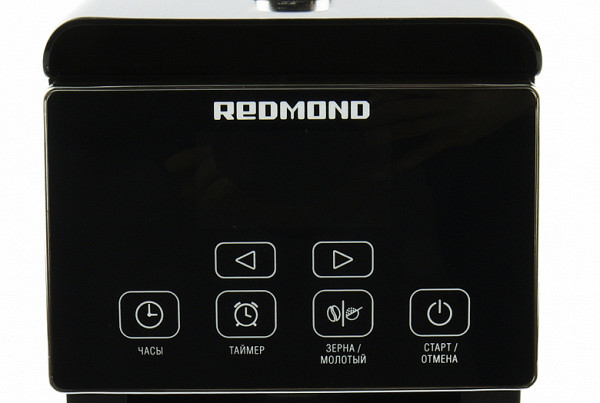
The large digital display shows the current time. The clock is adjusted using the «Clock» button and pointer sensors.
Redmond CM703 allows you to set the start time of cooking: the “Timer” button is used for this. To cancel a scheduled launch, you need to click on it a second time.
The type of drink is selected using the «Grains/Ground» touch button. By successive presses you can select the required degree of grinding, that is, the operating time of the built-in coffee grinder. It is also possible to turn off ground coffee.
The «Start/Cancel» button starts the device and allows you to interrupt cooking.
Simultaneously pressing two arrow buttons starts the self-cleaning process of the device.

The manual mentions a self-cleaning indicator that appears on the display after a certain number of coffees. However, when turning on the device, when all possible indicators briefly appear on the display, we do not notice this one. Instead, next to the grind degree icons, we see a one-character digital indicator, which is not used during operation and is not mentioned in the instructions.
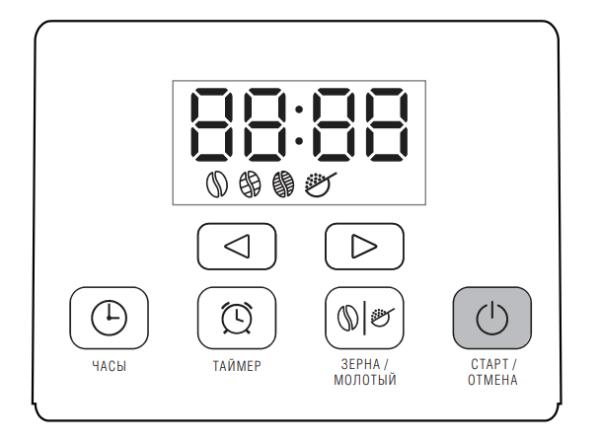
We do not see a self-cleaning indicator in the graphic part of the manual either. Probably, the mention of this function migrated into the instructions from the description of some other model.
Exploitation
Before you start using the coffee maker, you must remove all protective materials and advertising stickers from it, fill the reservoir with water and start the self-cleaning procedure by pressing both arrows at the same time. After this, you can start making coffee.
Redmond CM703 differs from most similar devices in its ability to use both ground and bean coffee. During testing, special attention was paid to preparing the drink from grains.
The device is a combination of a drip coffee maker and a rotary coffee grinder: the beans are added directly to the brewing chamber, which doubles as a grinding bowl. When using the «Grain» mode, the coffee maker first starts the grinder, grinding the contents, and then fills it with hot water.
The degree of grinding is regulated by the operating time of the coffee grinder: depending on the setting selected by the user (coarse, medium, fine), the electric motor runs for a certain time, regardless of the number of beans in the chamber. However, grind adjustment based on serving size is not available on this model.
The amount of water is also not regulated: when preparing coffee, the coffee maker uses all the liquid from the reservoir, since its volume coincides with the volume of the jug.
The optimal combination of beans, water and degree of grinding will have to be determined independently, depending on the user’s preferences and the type of coffee used. The device provides enough space for experiments.

The heating of the platform with the jug is activated automatically after preparation is completed and continues to operate for one hour. If you need to extend the operating time of the heater or warm up an already cooled drink, you can press the «Power» button.
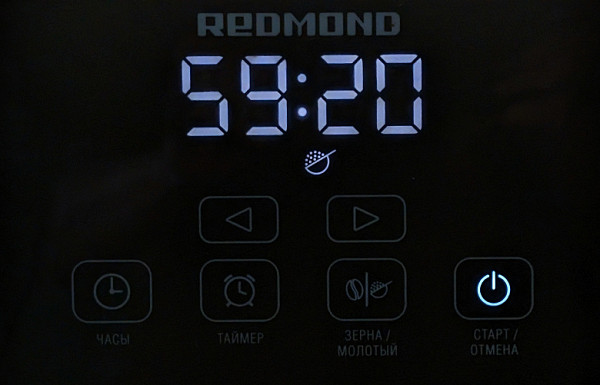
After cooking is completed, a countdown begins on the device screen: during this time, heating continues to operate. After each serving, remove the brewing unit, empty it, rinse it under warm water and dry it.
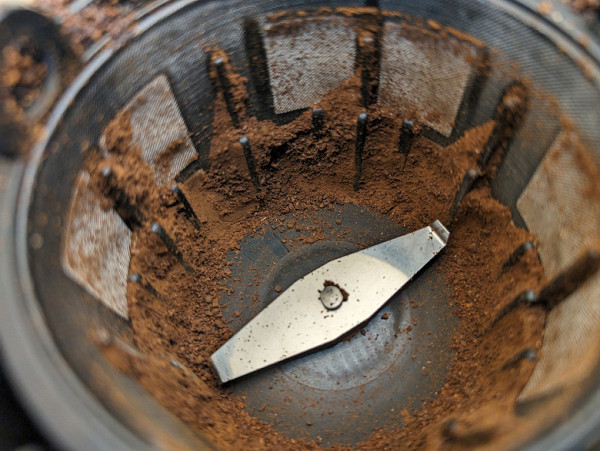
It is necessary to especially carefully monitor the dryness of the working chamber in this device: even a small amount of moisture remaining after washing can lead to fine coffee fractions sticking to the steel mesh the next time you start the coffee grinder. This may affect the uniformity of grinding and the quality of the drink.
Care
It is recommended to use mild detergents to clean the coffee maker's jug. The body of the coffee maker and the heating plate should be wiped with a damp soft cloth if necessary.
It is important to avoid exposing the device to running water, immersing it in liquid or washing it in a dishwasher. Do not use abrasive sponges or harsh chemicals when cleaning.
To remove scale, it is recommended to fill the tank with water to the maximum level and add a specialized product. Self-cleaning mode is activated by long pressing both arrow buttons at the same time. After all the liquid from the reservoir has passed through the coffee maker, you should drain the liquid from the jug, fill the reservoir with clean water and repeat the procedure.
Our measurements
In coffee preparation mode, the device consumes up to 894 W.
To prepare a standard serving of coffee (a full jug), the coffee maker consumes approximately 0.094 kWh in 7 minutes. If you turn on the heating of the jug for an hour, this figure will increase to 0.121 kWh.
The noise from the built-in coffee grinder is relatively low: according to our measurements, it does not exceed 70 dBA.
Practice tests
To determine the amount of coffee to use, it is generally accepted that the weight of the water should be approximately 15 times the weight of the beans. Thus, a coffee maker with a capacity of 800 ml of water will require 53 g of coffee. According to SCAA recommendations, this amount can be reduced to 44 g per 0.8 liters of water. However, during measurements and practical tests we used an average value: exactly 50 g.
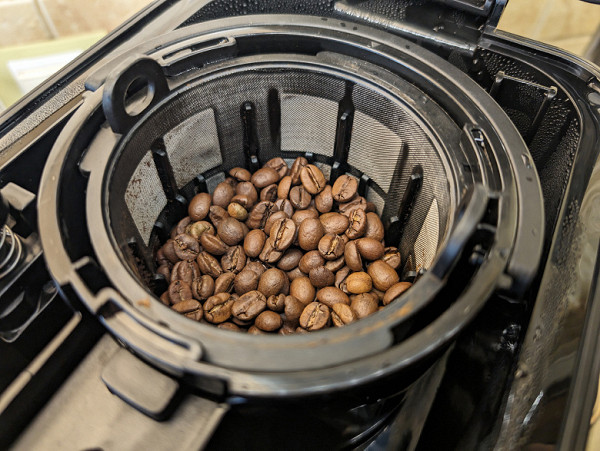
This amount occupies approximately half the volume of the brewing chamber.
Three grind levels
To evaluate the performance of the built-in coffee grinder, we conducted three tests, pouring 50 g portions of beans into the working chamber and running the device without water. We stopped the cooking process when the rotor completed its work.
The photographs show the results of the coffee grinder for coarse, medium and fine automatic grinding.
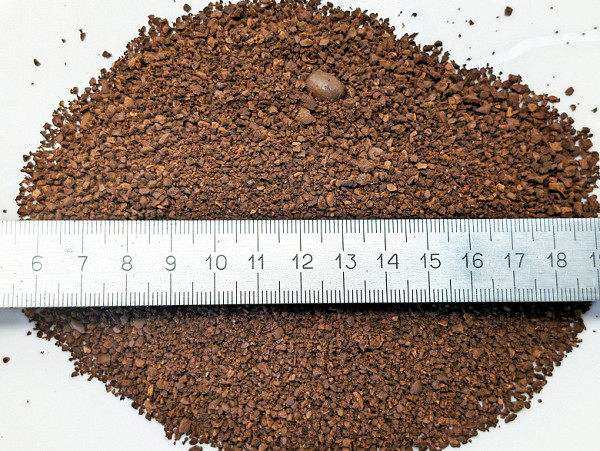
Coarse grinding corresponds to 14 seconds of grinding time. In the finished product we see a large number of large fragments and even two whole grains.

The medium grind (21 seconds) gives us a more acceptable result, although the unevenness of the grind is still noticeable.

To achieve a fine grind, the coffee grinder runs for 32 seconds. The grind uniformity is at a level acceptable for use with drip coffee makers.
We can notice that the built-in coffee grinder in this model is slightly inferior in grinding uniformity to classic models with a metal bowl. However, with maximum operating time it provides a fairly good result.
Result: good
Full jug of coffee
After discovering that the best results with the selected beans and roast were achieved with the finest grind, we used the same settings to brew a full (800ml) jug of coffee. We poured the appropriate amount of water into the tank.
A characteristic gurgle, indicating the end of the spill, was heard seven minutes after the end of the coffee grinder operation. At this point, we removed the lid from the brewing unit and examined its interior.

The temperature inside the chamber, according to our measurements, reached 82 °C. Although this is slightly lower than the recommended values, it is worth considering that as a result of heat loss, the actual cooking temperature may be slightly higher.
The unevenness of grinding in the built-in coffee grinder is especially noticeable on the surface: large fragments and splinters of grains float in the hot water and collect in the center of the chamber, while the fine fraction settles on the metal filter mesh.

After cooking was completed, the temperature in the jug was 76 °C. After twenty minutes it rose to 78 °C and remained at this level until the heating was turned off.
The quality of the finished drink is assessed as standard for home drip coffee makers: we received almost a liter of aromatic, not too strong coffee.
Result: good
conclusions
The Redmond CM703 coffee maker differs from typical drip models thanks to its built-in rotary coffee grinder. This will attract coffee lovers who value a fresh and aromatic drink, but do not want to additionally purchase or store a coffee grinder in the kitchen or office.

The noticeable grind unevenness we noticed during our hands-on testing diminishes as run time increases. By adjusting the grind intensity, bean portion size and water volume, every coffee lover can achieve the perfect combination of taste and aroma of the drink. Naturally, if desired, you can also use ready-made ground coffee in this coffee maker.
Among the disadvantages of the device, we note its relatively difficult maintenance: to achieve optimal results, you have to more closely monitor the condition of the working chamber compared to using conventional drip coffee makers with replaceable filters.
Pros:
- Possibility to use beans and ground coffee
- low price
- simple and convenient control
Minuses:
- Not very uniform grinding of the built-in coffee grinder
- relatively complex care
